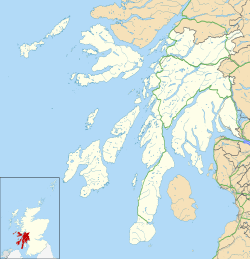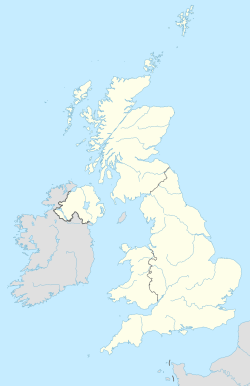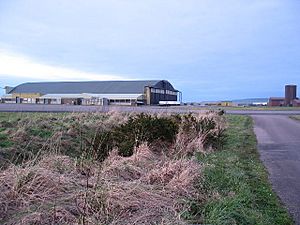RAF Machrihanish facts for kids
Quick facts for kids RAF Machrihanish
|
|||||||
|---|---|---|---|---|---|---|---|
| Near Campbeltown, Kintyre, Argyll and Bute in Scotland | |||||||
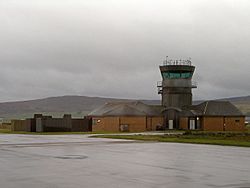
The control tower at former RAF Machrihanish in 2006
|
|||||||
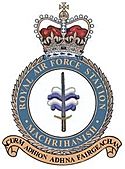
|
|||||||
|
Location within Argyll and Bute
|
|||||||
| Coordinates | 55°26′15″N 005°41′17″W / 55.43750°N 5.68806°W | ||||||
| Type | Royal Air Force flying station | ||||||
| Area | 415 hectares | ||||||
| Site information | |||||||
| Owner | Ministry of Defence (MOD) | ||||||
| Operator | Royal Naval Air Service and RAF (1918) Fleet Air Arm (1941–1963) RAF (1963–1995) MOD (1995–2012) |
||||||
| Condition | Closed | ||||||
| Site history | |||||||
| Built | 1918 | ||||||
| In use | 1918–1996 | ||||||
| Fate |
|
||||||
| Airfield information | |||||||
| Identifiers | IATA: CAL, ICAO: EGQJ, WMO: 03111 | ||||||
| Elevation | 12.8 metres (42 ft) AMSL | ||||||
|
|||||||
Royal Air Force Machrihanish or RAF Machrihanish was a former air base in Scotland. It was located near the town of Machrihanish, about 3.5 miles (5.6 km) west of Campbeltown. This area is at the very tip of the Kintyre peninsula in Argyll and Bute.
Two different airfields have been known as Machrihanish. The first one was used during the First World War. It was operated by the Royal Naval Air Service and the Royal Air Force. It closed after the Second World War. A second airfield was built during the Second World War. The Fleet Air Arm used it a lot during the war.
In the 1960s, this second airfield was updated. It became an RAF station and was also used by the US Navy. It stored special equipment and was a base for parts of the US Navy SEALs.
After the Cold War ended, the US military reduced its presence in Europe. The US Navy left Machrihanish on 30 June 1995. The base then became MOD Machrihanish and was kept ready for future use. In May 2012, the base was sold to a local group called the Machrihanish Airbase Community Company (MACC). MACC now runs the site as a business park. Part of the airfield is now Campbeltown Airport.
Contents
History of the Airfield
Early Days: First World War
The first airfield at Machrihanish was set up near the end of the First World War. It was about 2 miles (3.2 km) west of Campbeltown. This site was called Machrihanish Aerodrome and Mooring Out Station. It covered about 65 acres (26 hectares). It had wooden hangars and huts.
The Royal Naval Air Service (RNAS) ran it. It was a smaller base connected to the Luce Bay Airship Station. On 1 April 1918, the RNAS joined with the army's Royal Flying Corps. This created the new Royal Air Force (RAF). Machrihanish then became an RAF base. No. 272 Squadron started there on 25 July 1918. They flew Airco DH.6 planes on patrols to find submarines in the Firth of Clyde.
Machrihanish closed in late 1918. The airfield was then used for civilian flights. In the 1930s, it had regular flights to places like Islay and Belfast.
Second World War Use
The Fleet Air Arm (FAA) took over the airfield in 1940. In April 1941, it became known as Royal Naval Air Station (RNAS) Machrihanish. It was also called HMS Landrail. At the same time, a new airfield was built nearby for the FAA. This new airfield opened on 15 June 1941. It also became known as RNAS Machrihanish and HMS Landrail. The older airfield became a smaller, connected base called HMS Landrail II.
During the Second World War, Machrihanish was very busy. It was used a lot for training by many FAA and RAF aircraft. It also served as a base for squadrons from aircraft carriers. The airfield helped with patrols to find submarines and protect convoys. It became one of the three busiest stations in the UK. After the war, activity slowed down. The station closed on 16 April 1946. HMS Landrail II also closed and the land was returned to farming.
Cold War Era
After closing, Machrihanish was kept ready for use by the FAA. On 1 December 1951, it reopened as a smaller base for HMS Sanderling. It was used for a short time to train FAA pilots for the Korean War. They would fly from the aircraft carrier HMS Indomitable. It then went back to being kept ready for use on 30 September 1952.
Upgrading the Airfield
In April 1959, it was announced that the airfield would be upgraded. This was to support operations for the United States and NATO in the Clyde area and the Atlantic Ocean. NATO paid for these upgrades. The station was greatly redeveloped in the early 1960s. Land from seven farms and six small holdings was bought for this. Its four old runways were replaced. A new 3,049-metre (10,003 ft) runway was built. This allowed large planes like Avro Vulcan bombers to use the airfield.
Control of Machrihanish moved from the Admiralty to the Air Ministry on 27 May 1963. In June 1964, Machrihanish opened as an RAF station. It was part of No. 18 Group, which belonged to RAF Coastal Command. Even though it didn't have its own flying squadrons, it was a forward operating base for NATO. This meant it could be used if there was a war with the Soviet Union.
In the mid-1960s, the airfield became available for the US Navy. It was still an RAF station, but the US Navy's Commander in Chief, Atlantic Command, was in charge. The first US Navy staff arrived in mid-1967. On 7 March 1968, the Naval Aviation Weapons Facility Machrihanish (NAWF) opened. Its job was to store and move important equipment for the US Navy and NATO. The NAWF had a fenced area with concrete storage buildings. These buildings were designed to hold special equipment for anti-submarine warfare.

A group from the US Marine Corps arrived in 1974. They were there to provide security for the special equipment. In the early 1980s, US Navy SEALs units arrived. New buildings were built for the SEALs in the south-west part of the airfield. These included offices, training areas, and a firing range. A large hangar was also built.
From 1981, RAF Machrihanish was approved as a possible emergency landing site for the Space Shuttle. This would be used if the shuttle had a problem crossing the ocean. Between 1990 and 1995, a lot of money was spent on building work at the station.
Military Draw-down
After the Cold War ended, the US military reduced its forces in Europe. The US Navy left Machrihanish on 30 June 1995. They returned their facilities to the Ministry of Defence.
After the US Navy left, the station was called Ministry of Defence (MOD) Machrihanish. It was kept in a "care and maintenance" state. This meant it wasn't actively used, but it could be quickly reopened if needed. The airfield was still used for occasional military training exercises.
In March 1996, the Civil Aviation Authority gave Highlands and Islands Airports Ltd. (HIAL) a license. This allowed commercial flights to operate from the airfield. It then became known as Campbeltown Airport. In 2005, the MOD was still thinking about reopening the airfield for military use.
Closure and New Uses
Since there was no clear military future for the station, a local group was formed. The Machrihanish Airbase Community Company (MACC) started in March 2008. Local people wanted the site to be used to help the community.
On 6 October 2008, it was announced that Machrihanish was no longer needed for defence. It would be sold. On 14 May 2009, the site was advertised for sale. The MOD looked for private investors. Some local people were concerned because they felt they had not been asked for their opinion. They also worried that a community buyout was being ignored.
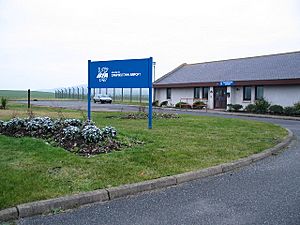
Plans for the community to buy the site faced problems in August 2010. The Scottish Government rejected the results of a local vote. They worried if the plans would work. However, after another vote, MACC successfully bought the site from the MOD for £1 on 11 May 2012. With support from various groups, MACC has made parts of the site available for businesses. Their goal is to create a good future for the Campbeltown area.
Campbeltown Airport still operates its part of the site. It has a long lease and is run by HIAL. Regular flights go to Glasgow Airport, operated by Loganair.
Station Badge and Motto
Machrihanish received its official station badge in 1975. The badge shows a silver Scottish sword, called a claymore. Behind the sword are four waves, which stand for the sea. This badge shows that the station was used for operations related to the sea.
The station's motto is in Scottish Gaelic. It says Airm a dhìonadh na fairgeachan. This translates to 'Arms to defend the sea'. This motto also highlights the station's important role in protecting the seas.
Conspiracy Theories
In the 1990s, there were rumors in the news. People thought that Machrihanish was being used by the US military to fly a secret experimental aircraft called Aurora. These rumors led to a question in the UK Parliament. A Member of Parliament asked about it. The Minister of State for the Armed Forces, Nicholas Soames MP, said that no such prototype aircraft was based at RAF Machrihanish. He also said that the UK government had not given permission for any such aircraft to operate from the United Kingdom.
See also
- List of former Royal Air Force stations


